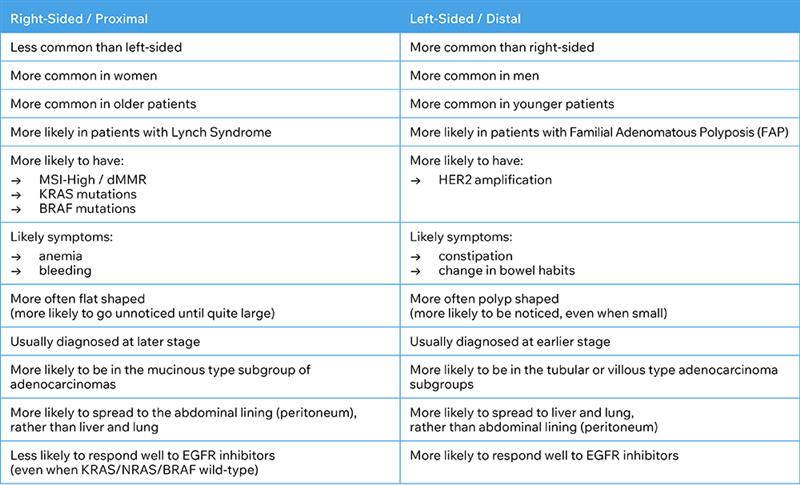

Tumor location refers to the site of the primary tumor (tumour) of your colorectal cancer. The large intestine (bowel) is made up of 6 segments, cecum (caecum), ascending colon, transverse colon, descending colon, sigmoid colon, and rectum.
The hepatic flexure (right colic flexure) is the turning point between the ascending colon and transverse colon. The splenic flexure (left colic flexure) is the turning point between the transverse colon and descending colon.
Colorectal cancer (bowel cancer) can develop in any of these locations.
Often, colorectal cancer is referred to as “right sided” or “left sided”. This is the “sidedness” of the tumor. Right-sided tumors, also known as proximal tumors, are located in the cecum, ascending colon, hepatic flexure, or the first two-thirds of the transverse colon. Left-sided tumors, also called distal tumors, are located in the last third of the transverse colon, splenic flexure, descending colon, sigmoid colon, or rectum.
Tumor location is both a prognostic biomarker and a predictive biomarker. This means that tumor sidedness gives information about the likely course of the disease (prognosis), and tumor location is a predictor of which treatments may be more or less effective for a particular colorectal cancer.
Several factors likely contribute to the differences in right-sided colon cancers and left-sided colorectal cancers.
Right-sided colon cancer has a better prognosis in early stages (stage I and stage II). Left-sided colon cancer has a better prognosis at advanced stages (stage III and stage IV / metastatic colorectal cancer).

The location of your colorectal cancer (CRC) may be identified in several ways. It may be described in imaging reports like CT scan, PET scan, or MRI scan. It can be noted in reports from surgical procedures like colonoscopy and colectomy (colon resection), or in pathology reports that describe the histology (microscopic characteristics) of your colorectal carcinoma.
Tumor location may be reported as “right-sided” or “left-sided”, or as “proximal” or “distal”. The specific location of your colorectal tumor will also be noted, such as splenic flexure, sigmoid colon, or rectum.
If your colorectal cancer is right-sided, also known as proximal, (located in the cecum, ascending colon, hepatic flexure, or first two-thirds of transverse colon)
If your colorectal tumor is left-sided, also known as distal, (located in the last third of the transverse colon, splenic flexure, descending colon, sigmoid colon, or rectum)
Additional targeted therapy treatment options may be indicated based on the results of other biomarker testing such as microsatellite stability (MSS) and microsatellite instability (MSI), RAS gene mutation status (KRAS or NRAS), BRAF mutation status, and HER2 amplification or overexpression status. Talk to your oncology healthcare team about further biomarker testing, and how your results can impact your treatment.
Tumor location should be determined for all colorectal cancer patients at the time of diagnosis.
A biomarker is a piece of information about your health. Biomarkers include your blood pressure, your blood type, and cholesterol or blood sugar levels measured in a blood test. The biomarkers of cancer are also known as tumor markers.